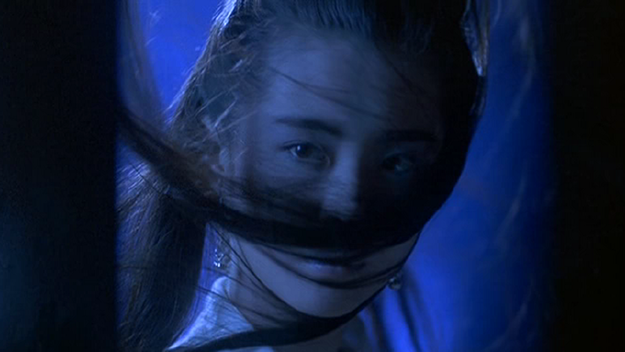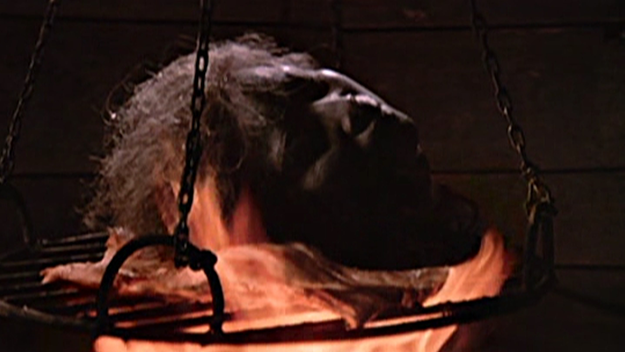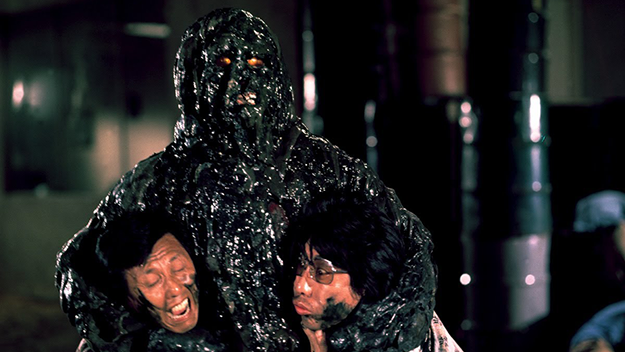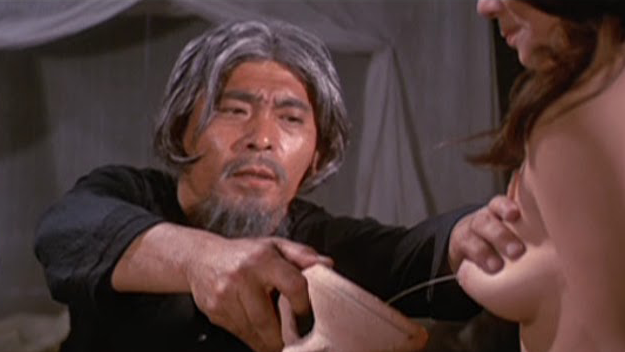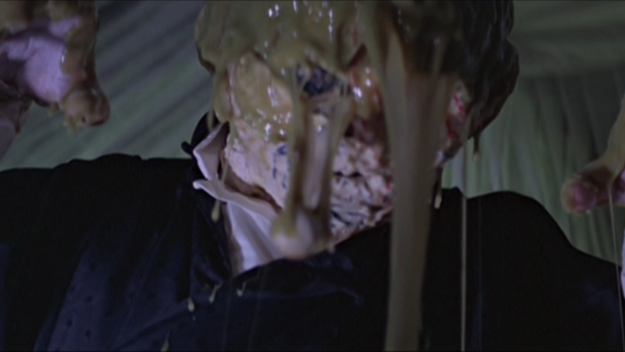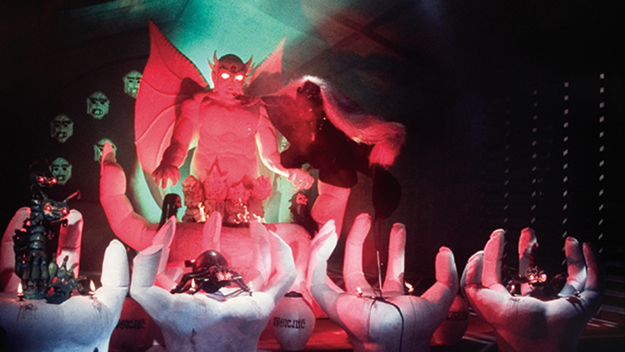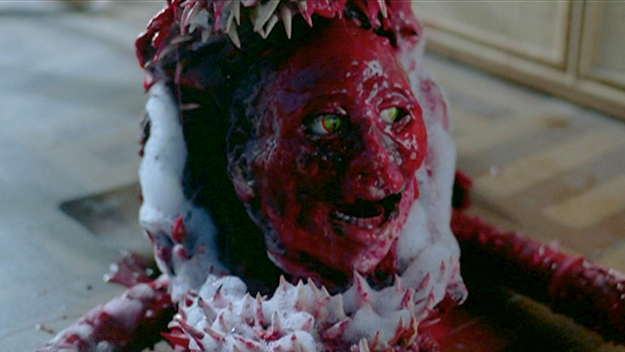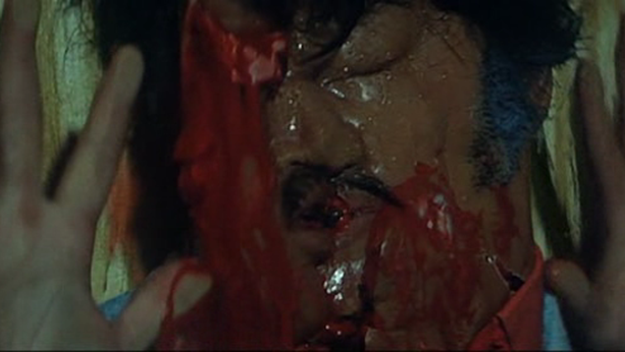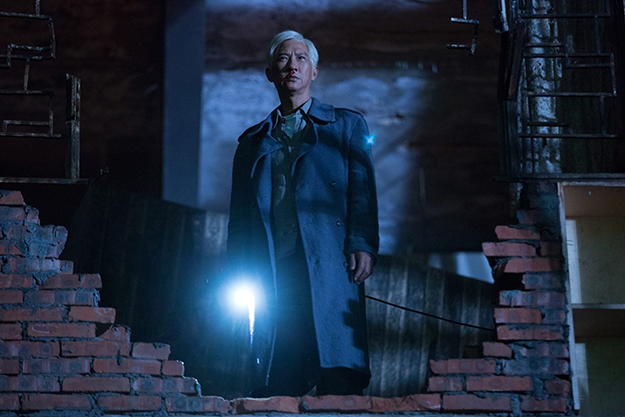A Chinese Ghost Story If your idea of Chinese horror is Tsui Hark’s phantasmal beauties swooping gracefully through blue-lit forests amidst yards of fluttering silk in A Chinese Ghost Story (87), or Li Han-hsiang’s film that inspired Tsui, The Enchanting Shadow (60), prepare for a hot poker in the eye. The 18th-century book Strange Tales from a Chinese Studio formed the basis for these and many other swanky productions about ghostly ladies, fox spirits, abandoned villas, and shadowy graveyards where loss, love, and longing are elegantly expressed. But in the mid-Seventies Shaw Studios erupted like a pus-filled boil with a series of grotty black-magic movies whose message wasn’t “Love lingers beyond the grave” but “Leave Hong Kong and die like a dog!!!” Most people blame Ho Meng-hua’s Black Magic (75) for this trend, but the seeds were planted earlier by Shaw’s 1974 co-production with Hammer Studios, Legend of the 7 Golden Vampires in which directors Chang Cheh and Roy Ward Baker partnered Peter Cushing with David Chiang against Dracula, who was hiding out in the Chinese countryside. A notorious boondoggle, it had been prompted by the international box-office-busting success of The Exorcist the year before, but its failure taught Run Run Shaw that he was better off going it alone when it came to horror movies. Shaw’s mean-spirited Gutcruncher in Chief, Kuei Chih-hung, almost immediately delivered Ghost Eyes (74), about an undead optometrist and his spooky contact lenses of doom. William Friedkin’s Exorcist may have been an outgrowth of sexual panic in Western society, but he never would have dared the bluntness of Kuei’s Ghost Eyes in which the evil ghost steals women’s lives through sex, one screw at a time. Ghost Eyes was one of the first Chinese movies to update ancient legends to contemporary Hong Kong and give shrill voice to foam-flecked fears about spread legs being a gateway to the graveyard. Ho took that formula and added a fear of foreigners in October 1975 when his Black Magic was unleashed and set the formula in stone.
Black Magic The formula: Scary foreigners + dirty foreigners + goopy black-magic rituals + sex + gross-out special effects + Scream Queen Tanny = Black Magic Movies Shaw’s stalwart leading man, Ti Lung, plays an intrepid young engineer living in Singapore whose life would be perfect if it wasn’t for trampy Tanny who wants his hot body even though he’s engaged to the virtuous Lily Li Li-li. The third (fourth?) point on this love triangle (quadrilateral?) is Lo Lieh, who wants Tanny, but she’d rather die than touch him. Pissed, Lo heads into the hills and engages the services of a local black-magician who whips up a love spell out of breast milk and snake venom. After a night of black-magic lovemaking, Tanny wakes up super-pissed off at Lo, but quickly realizes that witchcraft might be the key to Ti Lung’s heart. Ti and Lily have to turn to a good magician for protection—and then it’s all blood worms extracted from swollen bellies, Ti gobbling down a bowl of chopped centipedes in milk, Lo’s face exploding into maggoty mush, and a final battle of optical effects on top of a skyscraper under construction during which people age in time lapse and Ti Lung sprays some puke right before the final freeze frame. Singapore is depicted as a tropical hellhole where nightclubs and wedding halls are the civilized crust over a howling void of primitive superstition and back-stabbing Third World magicians who have one hand on your wallet and the other holding a candle under a cadaver’s chin to melt its fat for medicinal purposes. “Hey, Hong Kongers?” Ho Meng-hua says. “You know how when you go to a foreign country you’re constantly getting sold counterfeit watches? Well, watch out for the blood curses, too.” In other words, when you hire a necromancer to rub sticky rice on a girl’s breasts then make her drink black dog’s urine to cook up a love spell for your sweetie, you’d better keep the receipt.
Oily Maniac Next up was Kuei Chih-hung’s Spirit of the Raped (76) about a young woman who has the worst day ever (assaulted on a bus, husband killed, sold into prostitution, raped to death) so her vengeful ghost returns to make her tormentors grow extra heads, have their eyes plucked out, and their bellies to swell until they burst. Not really a black-magic movie, it’s a nice warm-up for the special-effects vomit-fests the genre was working up its nerve to unleash. Also, being set in Hong Kong, it misses the fear of foreigners that’s vital to a true black-magic movie. Ho Meng-hua went deeper into folklore and special effects with his Oily Maniac (76) in which Danny Lee played an ambulatory pile of poop haunting a Malaysian banana plantation. It’s all based on local legend and set in Malaysia, so of course the women are topless most of the time. Ho Meng-hua returned in December of 1976 with Black Magic 2, and within the first five seconds we’re in some primitive village where the local ladies doff their tops and dive into the river where they’re immediately consumed by an alligator. The old village wizard just shakes his head and sighs. This happens, he seems to say, as he guts the gator to return the chick’s treasured ankle bracelet to her not-so-ecstatic family, then wanders off down the road not to reappear until minute 56. Cut to a funk-a-licious tune and a plane landing as Ti Lung arrives in yet another hotter-than-Hell Southeast Asian country thick with humidity and blood curses. Set in “A Tropical City” (Singapore, actually), Black Magic 2 then follows Ti Lung, a doctor on vacation with his pals and Tanny, his wife. Lo Lieh plays an evil wizard who wears a pimp ring and hangs out in strip clubs where he takes a liking to the other doctor’s wife and immediately disguises himself as a flower delivery guy, swipes some of her blood, and hangs a rotten dog carcass on the property. This is not how you romance a lady. Or is it? Soon she’s hypnotized, visiting his house where he feeds her a potion made of her own charred pubic hair that causes her to lactate.
Black Magic 2 “Margaret, from now on I need to suck your breast milk at least twice a day,” he informs her, helpfully, revealing the secret of his eternal youth. Margaret winds up having a lot of sex with Lo Lieh and gives birth to a freakish mutant which makes her husband and Ti Lung and Tanny decide that something’s up. As per usual, it’s other cultures that are the problem, with Ti Lung’s doctor friend taking him to the ward to view victims of the numerous black-magic curses that fly through the air like so many mosquitoes carrying malaria. Showing them one grotesque victim, he says, “There is no medical term for this type of skin ulcer. It looks like a human face, so we call it Human-Face Sore.” Tanny’s always game to go dig up a grave in the name of science but their investigation is swiftly derailed when Lo Lieh gets inside her pants, too. Fortunately, the wizard from the opening shows up to beat her with a fox carcass, slit her back, and suck out green pus and worms. Everyone dies, and by the end only Ti Lung survives to put on his stealth hoodie and penetrate Lo Lieh’s creepy mansion where bizarre black-gowned figures lounge around the torture dungeon just kind of waiting for something to happen.
Hex After Black Magic 2, there was a brief gap of three years as Ho Meng-hua, Kuei Chih-hung, and the other young Turks of Shaw Studios spent their time on true-crime projects that mostly debuted in the five-part Criminals anthology series with lurid segment titles like “Teenager’s Nightmare,” “Nude in the Box,” and “The Deaf Mute Killer.” Then Kuei made the gothic Hex (80) which does star Tanny but isn’t a black-magic movie until a sudden deus ex exorcism in the final 10 minutes. That was followed by Corpse Mania (81), another atmospheric gothic that was more like a slasher film and whose only link to black-magic movies (besides the presence of Tanny) was its scenes of actors forced to lie still while clothed in squirming blankets of live worms. In 1981, Kuei delivered Bewitched, in which a happy Hong Kong daddy out in the country with his young scamp is horrified to find their picnic ruined by the discovery of a kiddie corpse with a long nail driven through the top of its skull. In short order, Melvin Wong has tracked down the killer who says he wasn’t responsible for killing his daughter because, natch, he just took a trip to Thailand. Jesus Christ, Thailand, cut it out. Turns out that this hapless sap romanced a local girl (their meet-cute is that he mistakes her for a whore) and, when he went home, she gave him a necklace that leaks poop on the full moon, causes his chest to grow hair, and turns his cute daughter into a blood hungry, liver-gobbling creep that he eventually kills on the advice of another wizard. Now the cop, Melvin Wong, has to go track down this Thai wizard who, fortunately, comes to Hong Kong and stinks up local hotel rooms with his Oil of Carcass Spell, Coffin Spell, Worm Spell, Lemon Spell, Split-Head Spell, Raising Demon Child Spell, and the self-explanatory Strangling Spell. A Thai monk turns out to be a good guy (mostly because he’s actually Chinese), and he helps Melvin track down the evil Thai wizard and explodes him in the departure lounge of Kai Tak airport. The last shot of the movie is a title card reading: “Simultaneously, the moral of this story is to admonish people against casual sex, and to be on guard against witchcraft.” Done and done.
Boxer’s Omen Bewitched was a dry run for Kuei’s magnum opus, Boxer’s Omen (83), which kicks off with a guy’s brother getting beaten to death in a Thai (again?) boxing ring, prompting his brother to head to the Land of Smiles for revenge. But once there, he discovers that his soul is somehow linked to the soul of a Thai monk who battled an evil Thai wizard for immortality, and there’s unfinished supernatural butt kicking to be done. Then it’s a series of supernatural showdowns and a trip to Nepal with massive sets and endless black voids that become the stages for puke battles between wizards. As terrified as these movies are of foreigners, they secretly served as vehicles to smuggle foreign superstitions and folklore into Hong Kong theaters. Ho Meng-hua’s somewhat plodding, square movies with their reliance on traditional narrative look like Fifties mental hygiene films next to Kuei Chih-hung’s screaming freak-shows full of lunatics. Kuei cares so little for scenes of people having rational conversations or delivering plot exposition that his movies only come to life when wizards stitch naked lady corpses inside crocodile bellies, then stuff their mouths with rotten chicken and group puke in a bowl. The scenes you’d normally find in a movie of, say, police tracking down clues or two lovers talking are so forgettable that they dissolve in your mind as you watch them until all that remains is a residue of surreal imagery. By the time Boxer’s Omen is over what little viewers can recall of that movie makes it sound like an acid trip or a vision quest that starts with a monk getting strangled by a flying head with dangling entrails and ends when a boxer barfs an eel, battles a giant crocodile, then turns his back on the whole affair and walks back into the material world. You can’t describe these movies without sounding like a crazy person, so they live inside your skull as intensely personal visions and your only relief is to show them to others. They’re like nightmares you’re too ashamed to tell anyone you’ve been having.
Seeding of a Ghost The genre mostly ended with the Christmas 1983 release, Seeding of a Ghost. Director Richard Yeung Kuen likes slow burns, and for its first 50 minutes, Seeding plays like a segment of the Criminals series. Phillip Ko (star of Boxer’s Omen) is a cab driver who rescues a black-magician from some thugs, but later, his wife is raped and murdered in an abandoned mansion. He goes to the wizard looking for help and, after having sex with a rotten corpse, revenge is served with a side of maggot-eating and pus. Seeding is a strange movie in that it all takes place in Hong Kong, bringing the blood curse home, and the black-magician isn’t evil. In fact, he warns Ko about the consequences of his actions, but no one ever listens. The finale goes off the rails with a pregnancy panic scene that attempts to duplicate the effects from The Thing (82) on a Hong Kong budget, but what it’s missing in slick execution it makes up for with sick enthusiasm. The Shaw black-magic movies are not deep. Sex is bad. Asian people who are not from Hong Kong are superstitious primitives who will give you VD that’ll make you murder your children. But while the spells and curses are loosely based on real folklore (Boxer’s Omen incorporates elements of Buddhism, Taoism, and Indonesia’s leyak) they become so unhinged from reality that they take on a surreal appeal that’s almost hypnotic. The first time you see worms squirming from cheap mortician’s wax boils you’ll laugh, the second time you’ll gag, but the fifteenth time you’ll stare in blank-faced acceptance and wonder who wrangled all those worms.
Devil Fetus Independent producers turned out some black-magic movies like Devil Fetus (83) and Black Magic with Buddha (83), and black-magic movies had occasional revivals such as The Eternal Evil of Asia (95) and Gong Tau (07) but by then the thrill was gone. The Shaw entries stand today as a goopy monument marking the moment when Hong Kong’s economy was booming and the locals were going on vacations all over Southeast Asia, sneering at the primitive ways of Malaysians, Indonesians, and Thais, while also scared shitless of what was hiding behind those familiar yet unfamiliar cultures. Hong Kongers looked down on other countries for being less Westernized than they, and yet they lived in fear that they were doomed to be punished by the old ways for becoming too Westernized themselves. And so Shaw Brothers (and others) punished them on screen for their arrogance, while confirming their snobbish suspicions, again, and again, and again.
LINKS! LINKS! LINKS!
It’s all horror, all the time in this Halloween links rundown!
Keeper of Darkness … Hong Kong star Nick Cheung is going full exorcist with his new movie Keeper of Darkness. The second turn in the director’s chair for this horror nerd (his first film was Hungry Ghost Ritual) sees him play a street exorcist who goes viral thanks to some YouTube videos and winds up running afoul of a ghost that wants to kill people just like him. You can check out the trailer here. … Cross-dressing Thai comedy-horror franchise Hor Taew Taek…Hak na Ka (now on its fifth installment) goes gothic this time as the girls return to their old boarding school to battle evil ghosts and a rival attempting a hostile takeover. The trailer is exactly as stupid as it sounds. Delightfully so! … Thai horror movie Arbat was recently banned for its depiction of Buddhist monks not acting very monkly. Now, three minutes of footage have been cut (a monk kissing a woman, some monks lifting a Buddha statue by the head), the title has been changed to Apatti, and it’s been given the green light for release. Fortunately, no one seems to have touched any of the footage of the ghost at the heart of the movie, a pret, which is a two-story-tall hungry ghost that is too tall to reach food anymore.
… Centipede Horror! While shooting his latest film, Operation Mekong, down in Malaysia, director Dante Lam was bitten by a six-inch centipede and had to be carried to the hospital, screaming in pain. He has now ordered anti-centipede boots for his entire crew. … Crimson Peak Banned in China! screams the Hollywood Reporter. Well, no. Instead, the movie’s producers are nervous that it might be, because it violates China’s ban on movies depicting the supernatural. But China has a soft spot for Guillermo del Toro and saved Pacific Rim’s bacon at the box office, so a ban (which hasn’t happened so far) would be a real blow to the movie’s grosses. Nevertheless, the story in HR is a fun, short piece with a few new tidbits about workarounds that Chinese directors have employed to get around the no-ghost rule. … Shock and horror, tinged with sadness. Essential Japanese film site, Midnight Eye, called it quits this summer. For years, this was one of the best places to find well-written, informed, and thoughtful writing on the Japanese film industry, and now the world has to figure out how to get along without it. There’s a goodbye from its founders, but why not say sayonara with this massive, 2005 look at the history of the J-horror genre, its roots, its birth, and its death by Nick Rucka—indicative of the deep analysis that was Midnight Eye’s specialty.
